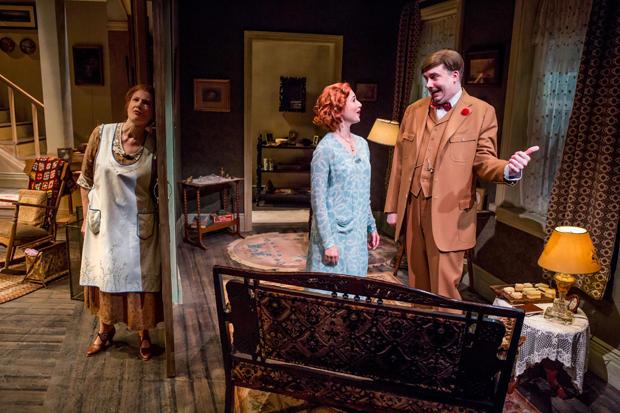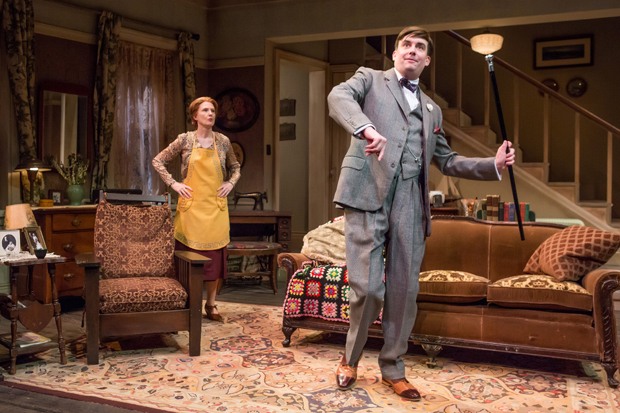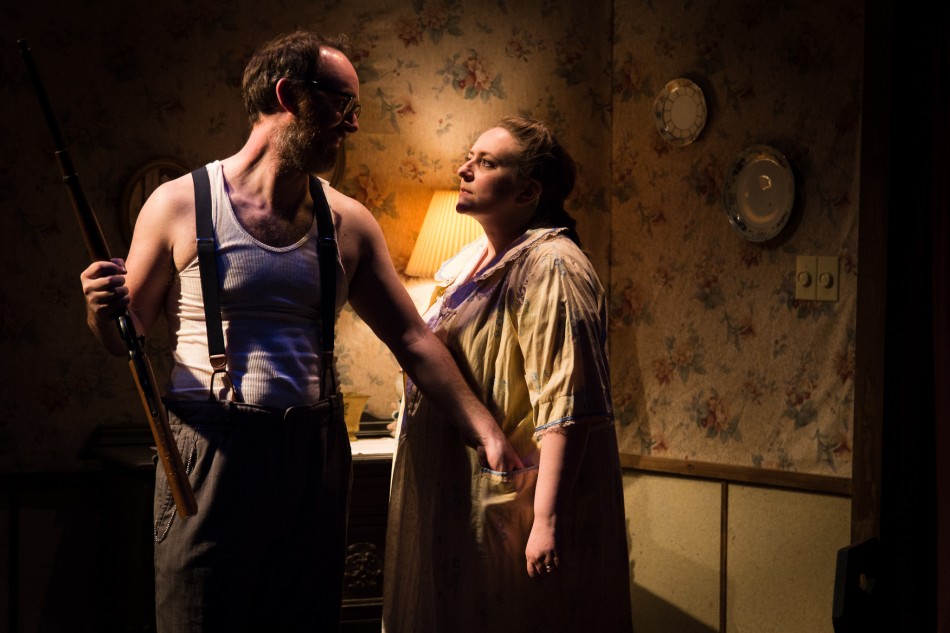by Samuel L. Leiter
No one says “the cat’s pajamas” in George Kelly’s The Show-Off but, in 1924, when this drawing-room, domestic comedy in the well-made play tradition opened, ran for 571 performances, and nearly won the Pulitzer Prize, it’s likely that’s what Broadway’s flappers and sheiks were calling it. The Peccadillo Theater Company’s warmed over current production of this old chestnut, directed by Dan Wackerman, reveals that those somewhat moth-eaten 93-year-old pajamas may still be wearable but they definitely need a better tailor to cover up their fraying parts.
The Show-Off, based on a Kelly vaudeville sketch, is named for its title character, Aubrey Piper (Ian Gould), a carnation-wearing, loud-mouthed, blustering, backslapping, hyperbolic, laughter-braying, toupee-wearing, chatterbox puffed to the gills with what his crustily sharp-tongued nemesis, Mrs. Fisher (Annette O’Toole), calls blatherskite. A program insert notes that “He is also more than a little bit of a huckster (i.e., a liar) and not unlike a well-known political figure of our day.” In fact, the only thing that makes us bear him is that, for all his exasperating faults, he’s essentially so good-natured that censure rolls off him like water from a duck’s back.
Aubrey, who earns $32.50 a week as a Pennsylvania Railroad clerk but calls himself “the pride of old West Philly” and acts like he’s the company owner, is the fiancé of Mrs. Fisher’s younger daughter, Amy Fisher (Emma Orelove). Her naïveté in adoring him (political junkies will make of this what they will) drives everyone to distraction, from her parents to her married sister, Clara (Elise Hudson) to her would-be inventor brother Joe (Tirosh Schneider).
Despite Mom’s warnings, Amy goes ahead and marries her boorish boyfriend only for the couple to eventually have to move in with her North Philadelphia family. Eventually, for all the trouble and expense Aubrey causes everyone, and the friction generated between him and Mrs. Fisher, this windbag blows a gust so big it lands a windfall for the family in an implausible ending even the play’s earliest supporters ridiculed for its contrivance.
There are laughs in The Show-Off but most are chuckles and only a few land big, although Kelly’s comedy can be praised for its spontaneous rather than deliberate quality. On the other hand, at least in this revival, there are long stretches, especially in Act Two (a compression of the original’s second and third acts), whose naturalistic tone is surprisingly serious (and dull).
Much of The Show-Off’s interest lies in its fussy preoccupation with the minutiae of everyday life, especially money; there are numerous citations reflecting contemporary salaries and costs. One that notes the $38 monthly rent for “a little two-story house” wouldn’t have rated a laugh in 1924 but does so today, while others, like the $42.75 Clara spent for a dress, a big expense back then, don’t register in 2017. Even the sum of $100,000, which plays a part in the plot, fails to explode at a time when it would be worth nearly $1,400,000. The producers offer a glossary of 1920s terms in the program: how about a note on monetary equivalences?
As Mrs. Fisher, the versatile Annette O’Toole again takes on a range-expanding role. She’s lively and acerbic enough but her take on this outspoken matron who doesn’t think twice about calling Italians “dagoes” fails to ring true; there’s something too self-conscious about her performance.
She’s far closer to the mark, though, than is Ian Gould as the buffoonish show-off. His audacious mendacity and pompous pronouncements never seem natural nor does the character’s innate charm ever peep through. When he fake-smokes one of those phony cigars now endemic in our tobacco-free productions it’s as artificial as a kid puffing a bubblegum cigar.
As the sisters, neither Ms. Orelove nor Ms. Hudson, bear any resemblance to each other or to Ms. O’Toole, but they do nicely by their not especially scintillating roles, while the rest of the company, like a stock company playing conventional types, are adequate to their tasks.
Harry Feiner’s borderline shabby living room set (which he also lit), with its upstage staircase, appears suitably lived in, while some of Barbara A. Bell’s not-so-roaring twenties costumes look period-appropriate and others don’t.
This is definitely not a show-off revival (the 1967 APA version, with Helen Hayes, came close) but it should prove satisfying enough for theatregoers curious about the most popular play by one of America’s foremost, if largely forgotten, dramatists of the 1920s and 1930s.
Photos: Jeremy Daniel
The Show-Off
Theatre at St. Clement’s
423 W. 46th St., NYC
Through October 21

























